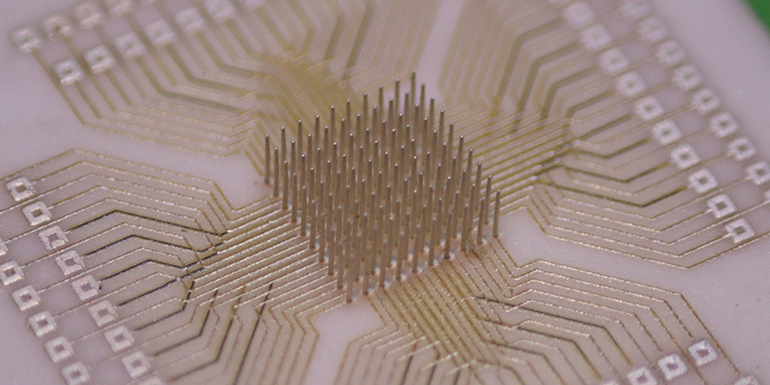Researchers at Carnegie Mellon University have used a nanoscale 3D printing technique that allows them to customize the microelectrode arrays used for brain computer interfaces. The approach is called Aerosol Jet 3D printing, and the researchers used it to create three-dimensional microelectrode arrays that can be customized for particular patient needs. Earlier microelectrode arrays could only record brain signals in two dimensions, limiting their applications. The new arrays are also denser than earlier devices, meaning that they are more robust.
Brain computer interfaces offer enormous possibilities in treating those with neurological deficits and in creating a whole host of assistive technologies for the disabled, including robotic prosthetic devices, brain-controlled wheelchairs, and communication devices. Many such technologies rely on microelectrode arrays, which form a vital link between neurons in the brain and electronic devices outside it, that can monitor and influence brain activity.
However, existing established microelectrode arrays, such as the Utah array or the Michigan array, have some limitations. These arrays cannot typically be customized to suit individual patients, and can usually only obtain recordings in two dimensions. Three-dimensional sampling is limited by the array density, but these newly created arrays have the highest array density of any produced thus far, with a density that is approximately one order of magnitude greater than that of the Utah array.
So, how did the researchers achieve this? They used a technique called Aerosol Jet 3D printing to create the arrays. “Aerosol Jet 3D printing offered three major advantages,” said Rahul Panat, a researcher involved in the project. “Users are able to customize their microelectrode arrays to fit particular needs; the microelectrode arrays can work in three dimensions in the brain; and the density of the microelectrode array is increased and therefore more robust.”
The researchers hope that the technology will pave the way for more effective brain computer interface systems, although it likely remains some years out from routine use in such systems. However, the progress to date is impressive, with the researchers already confident they can produce custom devices to address different patient needs.
“Within a matter of days, we can now produce a precision medicine device tailored to a patient or experimenter’s needs,” said Eric Yttri, another researcher involved in the study.
See a video about the technology below:
Study in journal Science Advances: CMU Array: A 3D nanoprinted, fully customizable high-density microelectrode array platform
